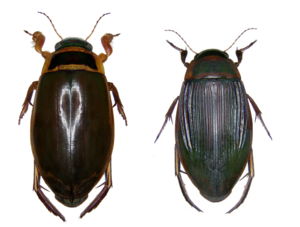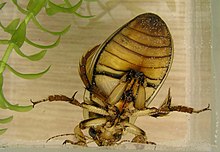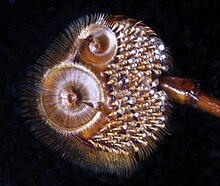Fire beetle
| Fire beetle | ||||||||||||
|---|---|---|---|---|---|---|---|---|---|---|---|---|

Males (left) and females; illustration |
||||||||||||
| Systematics | ||||||||||||
|
||||||||||||
| Scientific name | ||||||||||||
| Dytiscus marginalis | ||||||||||||
| Linnaeus , 1758 |
The yellow beetle or common yellow fire ( Dytiscus marginalis ) is a beetle from the family of swimming beetles (Dytiscidae). It is the most common representative of its genus in Central Europe .
features
The beetles reach a body length of 27 to 35 millimeters. Their body is broadly oval in shape. The pronotum and the wings are edged yellow, otherwise black-green and smooth in the male, green-brown in the female and grooved lengthways on the front two-thirds. However, there are also female individuals who have smooth bodies. The males also differ from the females by their organs of attachment on the tarsi of the front legs. There are one large, one medium and around 160 small suction cups. When mating, the male uses these suction cups to hold the female in place. The underside of the body is yellow-brown. The runners of the rear hips are slightly elongated, the inner edges are convex in shape, which distinguishes them from the other species of the genus. The rails ( tibia ) and tarsi of the hind legs are densely covered with bristles that serve as paddles when swimming.
Occurrence
The species occurs in almost all of Europe , north to central Norway and northern Sweden . It is absent in southern Spain and Greece . To the east, the distribution area extends over the Caucasus to Siberia to Japan , and North America is also populated. The animals live in stagnant water from the plains to the hill country. Their development is dependent on early-spawning amphibian species, as the larvae have a great need for food. This can only be adequately covered by tadpoles. Therefore, the drop in the population of jellyfish can also be attributed to the decline in amphibian populations.
Way of life
Jellyfish beetles are very good swimmers and fliers. The beetles also fly over land to seek out new habitats, which they usually do at night. They regulate their specific weight by filling and emptying a section of the rectum (rectal ampoule). This allows them to expel the faeces in them in case of danger. The animals feed on small and larger animals living in the water such as insect larvae, tadpoles and weak or sick small fish. The females lay their eggs, about seven millimeters long, individually in plant tissue. To do this, they cut into the tissue of aquatic plants with their ovipositor , which is around 10 millimeters long . They hold on to the plants with their front and middle pairs of legs and brace their back legs against them. Finally, the incision is closed with a secretion. A total of around 1000 eggs are laid between March and April.
The larvae hatch at different times depending on the temperature and oxygen content. Their body is elongated, has a large head with powerful mandibles and is 60 to 80 millimeters long when fully grown. They are just as predatory and suckle their mandibular-gripped victims. They also eat conspecifics. When they are fully developed, they make a doll's cradle out of earth and saliva, shallow under stones or wood , in which they pupate and the imago then hibernates.
Web links
literature
- Karl Wilhelm Harde, Frantisek Severa and Edwin Möhn: The Kosmos Käferführer: The Central European Beetles. Franckh-Kosmos Verlags-GmbH & Co KG, Stuttgart 2000, ISBN 3-440-06959-1 .
- Jiři Zahradnik, Irmgard Jung, Dieter Jung et al .: Beetles of Central and Northwestern Europe. Parey, Berlin 1985, ISBN 3-490-27118-1
Individual evidence
- ↑ Jochen Gerhard Mölle: On the importance of amphibian larvae for the population development of the common yellow beetle Dytiscus marginalis, L. 1758, p. 194 ff. Http://d-nb.info/966369181/34



